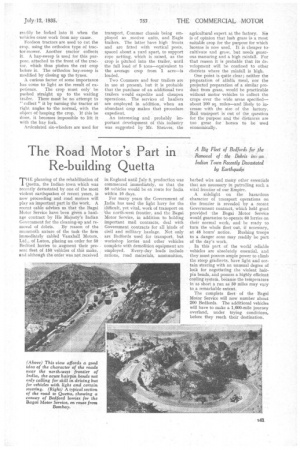A New Industry that Depends on Commercial Motors
Page 54

Page 55

If you've noticed an error in this article please click here to report it so we can fix it.
Without Road Mechanical Transport, the Preparation of Animal Meal Could Not be Carried On in an Economic Manner
THE activities of Animal Food Products, Ltd. (a subsidiary concern of the Anglo-Scottish Beet Sugar Corporation), at Felstead, Essex, are, on several grounds, of interest to readers of The Commercial Motor.
They afford new opportunities of the use of road transport, they enable a percentage of the personnel of a sugar. beet factory to be kept engaged throughout the summer months, and— perhaps, most important of all—they exemplify yet another instance of a new industry which would not .be practicable without the aid of the commercial motor. The railways would be of no use whatever.
MO The factory processes involved are similar to those described in our issue dated September 15, 1933, in which we referred to a newly established cropdrying business at Southacres. Crops which the farmer formerly referred to as temporary leys—mainly lucerne (or alfalfa), clover or sainfoin, hitherto hayed, fed direct to cattle and livestock, or stored in silos, are garnered by this company, dried and ground, sacked and sold as a dry and palatable meal, rich in proteins and vitamins and valuable as food for all kinds of livestock and poultry.
The whole of the company's output, up to a certain figure, is taken by the Agricultural Foods Products Co., the proprietor of Vitamelo pig-meal.
The factory enters into agreements with farmers resident within a radius of 12-15 miles, but including occasionally, as convenience or attractiveness of crop dictates, some outlying field beyond that radius. The factory agrees to take all the crops from given fields-. over the period specified in the contract, and the fields are then usually sown with lucerne.
The agreement covers five to seven years and all the farmer is asked to do is to sow the seed, apply appro priate manures, and to keep the crop in a clean condition, taking, also, steps to ensure that no livestock has access to it. The farmer is paid an agreed figure per green ton of the crop as harvested and weighed at the factory, and there his responsibility ends. '
The operating company cuts the crop, collects it, and makes provision for its transport to the factory. The.ie it is thrown on to a conveyer-elevator, which transfers it to the inside of the factory, where it is cut (to lengths of about 1-i in.), kiln-dried, ground to powder, and sacked. All these opera-. tions are performed by machinery and the labour employed is that which, during the campaign, is engaged in the sugar-beet factory.
As the factory operates for 21 hours per day, and as harvesting and transport may not be convenient at all times, it is necessary to provide transport in excess of the factory capacity, which is approximately four tons per hour SO tons per day of wet material, resulting in an output of some 20 tons of dried meal. To that end, some of the crop is deposited on the ground close to the conveyer, so that it may readily be forked into it when the vehicles cease work from any cause.
Fordson tractors are used to cut the crop, using the orthodox type of tractor-mower. Another tractor collects it. A hay-sweep is used for this purpose, attached to the front of the tractor, which thus pushes the cut crop before it. The orthodox hay-sweep is modified by closing up the tynes.
A curious factor of some importance has come to light as the result of ex
perience. The crop must only be pushed straight up -to the waiting trailer. There must be no attempt to "collect " it by turning the tractor at right angles to the normal, with the object of -heaping the crop. If this be done, it becomes impossible to lift it with the hay fork.
Articulated six-wheelers are used for transport, Commer chassis being employed as motive units, and Eagle trailers. The latter have high fronts and are fitted with vertical posts, spaced about a yard apart, to support rope netting, which is raised, as the crop is pitched into the trailer, until the full load of 5 tons—equivalent to the average crop from 1 acre—is loaded.
Two Commers and four trailers are in use at present, but it is probable that the purchase of an additional two trailers would expedite and cheapen operations. The services of hauliers are employed in addition, when an abundant crop makes that procedure expedient.
An interesting and probably important development of this industry was suggested by Mr. Sheaves, the agricultural expert at the factory. He is of opinion that lush grass is a most suitable crop for the purpose for which lucerne is now used. It is cheaper to. cultivate and grow, but needs generous manuring and a high rainfall. For that reason it is probable that its development will be confined to other districts where the rainfall is high.
One point is quite clear ; neither the preparation of alfalfa meal, nor the projected preparation of a similar product from grass, would be practicable without motor vehicles to collect the crops over the wide areas specified— about 100 sq. miles—and likely to increase with the size of the factory. Rail transport is out of the question for the purpose and the distances are too great for horses to be used economically.




























































































